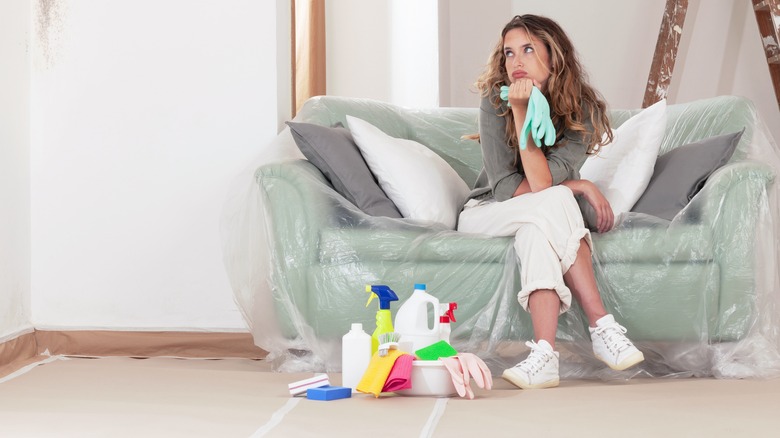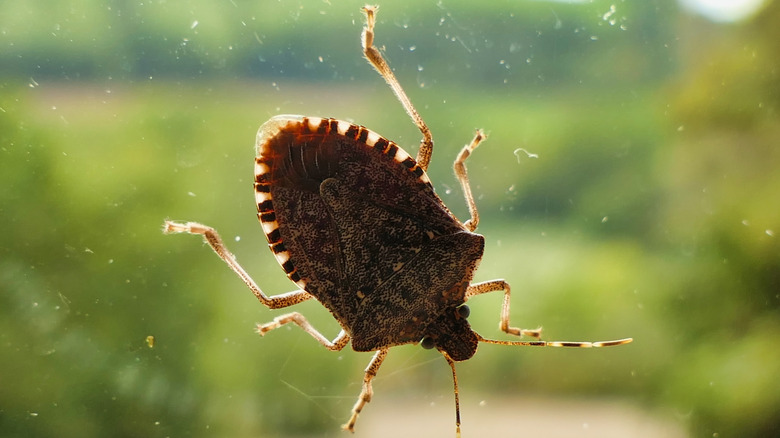The Invasive Pest That Could Cause Problems In Your Home
An influx of pests in the home is always gross and concerning, especially when you aren't sure about the health dangers they pose or what damage they can do. Your home could be full of an annoying but harmless bug, or it could be one of the pests that will do by far the most damage to your household. While luckily not considered very dangerous, one pest that can cause damage to items in your home if you don't get the infestation under control is the stink bug.
From the "stink" in the name alone, homeowners often know that they should be somewhat concerned about an infestation of these bugs in the house. Brown marmorated stink bugs (Halyomorpha halys) are a type of brown, shield-shaped bug that is roughly the size of a dime. The species is native to Asia and has been present in the United States as an invasive species since the 1990s. These bugs are most commonly found as an agricultural pest in the mid-Atlantic region, but they are present in 38 states, making them a widespread issue. Besides the harm these bugs do to crops, they are also known to enter people's homes for shelter, especially during colder months, creating stains around the home.
Once they feel safe inside your home, although they won't reproduce, they can release an aggregation pheromone that lets other stink bugs know they should join. This is why if you see one stink bug, you should act fast to prevent any potential damage from multiplying. Just be sure you get rid of them correctly rather than squishing them, or you will unfortunately learn how they got their unpleasant name.
Stink bugs can cause staining in your home
If you are dealing with stink bugs in your home, the good news is that you do not need to worry about structural damage caused by the bugs. The bad news is that stink bugs can leave stains on fabrics in your home. On carpets, curtains, upholstered furniture, and more, you may find brown stains of various sizes that persist even after a cycle in the washing machine. These stains are notoriously difficult to remove, further exemplifying how important it is to take preventative measures.
If you do want to attempt to remove these stains, some people have had success using a combination of baking soda, hydrogen peroxide, dish soap, and hot water to get stains out of curtains. For a wash like this, you would typically want to patch test the fabric to see how it holds up to the solution, though for severe staining, it may not seem necessary. Soak the fabric in the solution for around an hour, wring it out, and wash it in your washing machine. Keep an eye on the machine to ensure it does not create too many suds, and check that the fabric is thoroughly rinsed.
You may also see stink bug trails along window panes, walls, countertops, and other furniture. These excrement trails should be easier to clean off of solid, non-porous surfaces than fabrics, and all you need to do is use soap and water. Removing the stains not only makes your home look and feel cleaner, but it also stops other bugs from following the trail.
How to deal with stink bugs in your home
Of course, dealing with stain removal is a bit silly if you do not also address the cause of the stains. In fact, the stains can even help you locate all of the bugs by giving you a path to them. More stains mean more bug activity. Once you find the pests, part of your solution will involve removing the existing bugs by knowing how to eradicate stink bugs without releasing their scent, and the other part will involve preventing stink bugs from entering your home. The best way to deal with stink bugs is to vacuum them. If you don't have a suitable vacuum, you can also pick up the stink bug with a tissue and throw it away outside. Whatever your method, be sure not to squish the bug.
Once the bugs are out, you need to make efforts to prevent them from re-entering. Assess your home for cracks or access to the outdoors, especially in areas where you have found bugs. Check around windows and doors, outlets, ceiling fixtures, and vents. Broken screens on windows and doors should be replaced, and exterior and interior cracks should be caulked and sealed. Even if your home is sealed, stink bugs can find ways inside. Experimenting with other methods, such as some natural ingredients you should use to keep stink bugs out of your house or insect repellent for stink bugs, can help further reduce the likelihood of entry and, consequently, the likelihood of stained, damaged items in your home.


